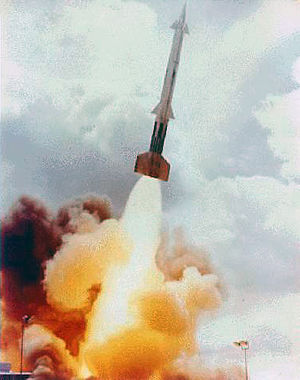
Back معاهدة الصواريخ المضادة للباليستية Arabic Smlouva ABM Czech ABM-traktaten Danish ABM-Vertrag German Tratado sobre Misiles Antibalísticos Spanish پیمان موشکهای ضد بالستیک Persian ABM-sopimus Finnish Traité ABM French एंटी बैलेस्टिक मिसाइल संधि Hindi Traktat Peluru Kendali Anti-Balistik ID
This article needs additional citations for verification. (May 2017) |
 | |
| Type | Bilateral treaty |
|---|---|
| Signed | 26 May 1972 |
| Location | Moscow, Russian SFSR, USSR |
| Expiry | 2002 (U.S. withdrawal) |
| Signatories | |
| Parties | |
| Ratifiers | |
| Full text | |
The Anti-Ballistic Missile Treaty, also known as the ABM Treaty or ABMT, was an arms control treaty between the United States and the Soviet Union on the limitation of the anti-ballistic missile (ABM) systems used in defending areas against ballistic missile-delivered nuclear weapons. It was intended to reduce pressures to build more nuclear weapons to maintain deterrence.[1] Under the terms of the treaty, each party was limited to two ABM complexes, each of which was to be limited to 100 anti-ballistic missiles.[2]: 115
Signed in 1972, it was in force for the next 30 years.[3] In 1997, five years after the dissolution of the Soviet Union, four former Soviet republics agreed with the United States to succeed the USSR's role in the treaty, with Russia assuming all rights and obligations as the successor state of the Soviet Union. Citing purported risks of nuclear blackmail, the United States unilaterally withdrew from the treaty in June 2002, leading to its termination.
- ^ Acton, James M. (13 December 2021). "The U.S. Exit From the Anti-Ballistic Missile Treaty Has Fueled a New Arms Race". Carnegie Endowment for International Peace. Archived from the original on 20 June 2022. Retrieved 12 September 2022.
- ^ Nash, Henry T. (1 May 1975). Nuclear Weapons and International Behaviour. Kluwer Academic Publishers. ISBN 978-9028602656 – via Internet Archive. p. 115:
Each site would consist of 100 ABMs, or a total of 200 ABMs for each country
- ^ "Treaty Between the United States of America and the Union of Soviet Socialist Republics on the Limitation of Anti-Ballistic Missile Systems". Bureau of Arms Control. United States Department of State. 26 May 1972. Archived from the original on 9 March 2022. Retrieved 13 September 2022.